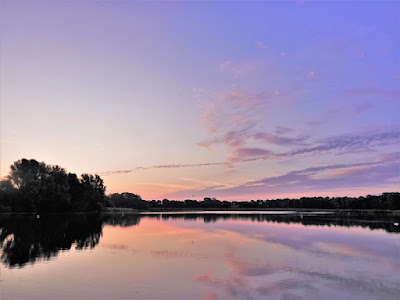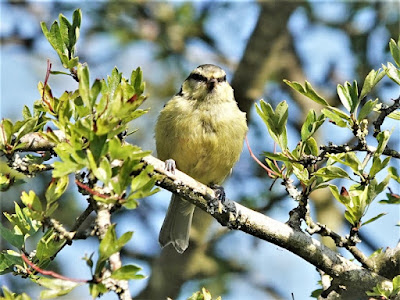13.0°C > 20.0°C: Some high cloud otherwise fine and clear of somewhat hazy. Light and variable breeze. Very good visibility.
Sunrise: 05:27 BST
* = a species photographed today
! = a new species for me here this year
!! = a new species for me in Shropshire
Priorslee Balancing Lake: 05:00 – 06:15 // 07:10 – 09:25
(166th visit of the year)
A very quiet morning, especially later with very few insects about. Too hot?
Bird notes:
- only the resident Mute Swans remain.
Counts of birds noted flying over:
- 42 Canada Geese: 60 outbound in five groups; a single inbound with Greylags
- 33 Greylag Geese: 25 outbound in six groups; eight inbound in three groups
- 2 Stock Dove: together
- 193 Wood Pigeons
- 2 Herring Gulls
- 22 Lesser Black-backed Gulls
- 88 Jackdaws
- 3 Rooks
- 2 Starlings
Hirundines etc. noted:
- 2 Barn Swallows
- 2 House Martins
Warblers noted (the figure in brackets relates to birds heard singing):
- 7 (0) Chiffchaffs
- *11 (1) Reed Warblers
- 5 (0) Blackcaps
- 1 (1) Common Whitethroat
'nominal' warbler:
- no Goldcrests
Counts from the lake area:
- 32 Canada Geese: one early; all the others arrived in five groups
- 1 Greylag Goose: departed
- 2 Mute Swans
- 20 (?♂) Mallard
- 6 adult and juvenile Moorhens
- 54 adult and juvenile Coots
- 5 + 1 (1 brood) Great Crested Grebes
- 12 Black-headed Gulls at most on the lake. Just five on the academy's own football field at 06:00
- 2 Herring Gulls: briefly
- 2 Lesser Black-backed Gulls: briefly
- 1 Grey Heron: arrived
- 2 Kingfishers: four sightings of at least two birds
Noted on the street lamps poles pre-dawn:
Moths:
- *1 Blue-bordered Carpet Plemyria rubiginata
- *1 Blue-bordered Carpet Plemyria rubiginata
Spiders, harvestmen etc.
- 1 harvestman Dicranopalpus ramosus/caudatus
- *1 harvestman perhaps Opilio saxatilis
Noted later:
- 1 harvestman Dicranopalpus ramosus/caudatus
- *1 harvestman perhaps Opilio saxatilis
Noted later:
Butterflies:
- Meadow Brown Maniola jurtina
- Gatekeeper Pyronia tithonus
- Meadow Brown Maniola jurtina
- Gatekeeper Pyronia tithonus
Moths:
- Straw Grass-moth Agriphila straminella [was Straw Grass-veneer]
- Straw Grass-moth Agriphila straminella [was Straw Grass-veneer]
Bees, wasps etc.:
- Honey Bee Apis mellifera
- Garden Bumblebee Bombus hortorum
- *Tree Bumblebee Bombus hypnorum
- *Common Carder Bee Bombus pascuorum
- Honey Bee Apis mellifera
- Garden Bumblebee Bombus hortorum
- *Tree Bumblebee Bombus hypnorum
- *Common Carder Bee Bombus pascuorum
Hoverflies:
The first name is that used by Stephen Falk. The name in square brackets is that given by Obsidentify or other sources if different. Scientific names are normally common. The species are presented in alphabetic order of those scientific names.
- Marmalade Hoverfly Episyrphus balteatus
- Tapered Dronefly Eristalis pertinax
- *Common Twist-tail Sphaerophoria scripta [Long Hoverfly; Common Globetail]
- Marmalade Hoverfly Episyrphus balteatus
- Tapered Dronefly Eristalis pertinax
- *Common Twist-tail Sphaerophoria scripta [Long Hoverfly; Common Globetail]
Damsel-/dragon-flies:
- Southern Hawker Aeshna cyanea
- *Common Blue Damselfly Enallagma cyathigerum
- Broad-bodied Chaser Libellula depressa
- Southern Hawker Aeshna cyanea
- *Common Blue Damselfly Enallagma cyathigerum
- Broad-bodied Chaser Libellula depressa
Other flies:
- only unidentified flies noted
- only unidentified flies noted
Bugs etc.:
- none
- none
Beetles:
- none
- none
Molluscs:
- White-lipped Snail Cepaea hortensis
- White-lipped Snail Cepaea hortensis
Spiders, harvestmen etc.
- *Bridge Orb-web Spider Larinioides sclopetarius
*Feedback from the Shropshire bee recorder about Monday's Leafcutter Bee . A positive identification is not possible without more detailed examination. It was most likely a Patchwork Leafcutter Bee Megachile centuncularis.
- *Bridge Orb-web Spider Larinioides sclopetarius
*Feedback from the Shropshire bee recorder about Monday's Leafcutter Bee . A positive identification is not possible without more detailed examination. It was most likely a Patchwork Leafcutter Bee Megachile centuncularis.
The sunrise according to my ancient Samsung phone.
And according to my Sony camera.
There was some haze and few clouds to the East to liven things up slightly.
"Feed me!". A juvenile Reed Warbler begs a parent to feed it.
...to beg for more.
Normally this species is characterised by the sloping forehead to the quite large, for a warbler, bill. That does not show here.
Another Blue-bordered Carpet moth Plemyria rubiginata I found on a street lamp pole before sunrise. The 'blue' of the border is rarely obvious. As with many moths the coloured scales rapidly fade and wear away after emergence. Colour is more to do with camouflaging the caterpillar stage than appearing attractive in the imago phase. Most butterflies and moths find a mate using pheromones.
A Tree Bumblebee Bombus hypnorum.
And a Common Carder Bee Bombus pascuorum on the flower of Water Mint Mentha aquatica.
A Common Twist-tail hoverfly Sphaerophoria scripta at the stigma of a Broad-leaved Willowherb Epilobium montanum flower.
"Me and my shadow". A male Common Blue Damselfly Enallagma cyathigerum. Neither species of dragonfly I noted today would hang around for a photo.
A well-behaved Bridge Orb-web Spider Larinioides sclopetarius sitting on a white sign on the boxing ring.
A bit too high up a street lamp pole for anything more than a record shot. The very long and banded legs suggest this harvestman is perhaps Opilio saxatilis.
The probable Patchwork Leafcutter Bee Megachile centuncularis from Monday.
(Ed Wilson)
------------------------------------------------------------------------------------------------------
Other things:
- 16 White-legged Snake Millipedes Tachypodoiulus niger
(Ed Wilson)
The Flash: 06:20 – 07:05
- 16 White-legged Snake Millipedes Tachypodoiulus niger
(Ed Wilson)
------------------------------------------------------------------------------------------------------
The Flash: 06:20 – 07:05
(169th visit of the year)
Bird notes:
Bird(s) noted flying over here:
None
Hirundines etc. noted:
- 2 House Martins
Warblers noted (the figure in brackets relates to birds heard singing):
- 3 (0) Chiffchaffs
'nominal' warbler:
- no Goldcrests
Noted on / around the water:
- 18 Canada Geese
- 3 Greylag Geese
- 2 + 3 (1 brood) Mute Swan
- 16 (?♂) Mallard
- 23 (?♂) Tufted Duck
- 7 + 2 (1 brood) Moorhens
- *67 + 2 (2 broods) Coots
- 3 Great Crested Grebes
- 1 Black-headed Gull
- 1 Grey Heron
Noted elsewhere around The Flash:
Hirundines etc. noted:
- 2 House Martins
Warblers noted (the figure in brackets relates to birds heard singing):
- 3 (0) Chiffchaffs
'nominal' warbler:
- no Goldcrests
Noted on / around the water:
- 18 Canada Geese
- 3 Greylag Geese
- 2 + 3 (1 brood) Mute Swan
- 16 (?♂) Mallard
- 23 (?♂) Tufted Duck
- 7 + 2 (1 brood) Moorhens
- *67 + 2 (2 broods) Coots
- 3 Great Crested Grebes
- 1 Black-headed Gull
- 1 Grey Heron
Noted elsewhere around The Flash:
Moths:
- none
- none
Beetles:
- 1 Alder Leaf Beetle Agelastica alni larva
- *1 unidentified beetle
- 1 Alder Leaf Beetle Agelastica alni larva
- *1 unidentified beetle
Spiders, harvestmen etc.
- none
- none



































































